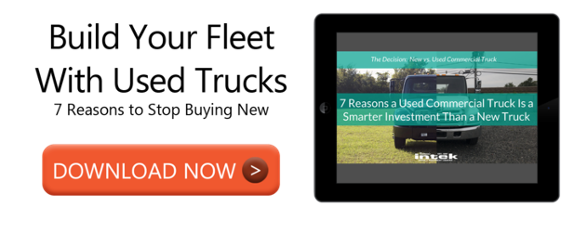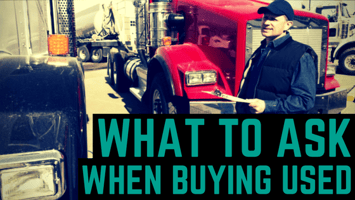Purchasing a used truck from a private seller requires that you know what you’re doing and follow...
Top 5 Warnings Your Commercial Tires Are Trying to Give You
Depending on your truck fleet size, commercial tires can be your second-highest cost, behind fuel.
Maximizing your tire life will lead to premature replacement and hamper fuel economy. Understanding tire wear and tear can save you money and keep your drivers safe.
If you hurt your leg and compensate by adjusting how you walk and run, you often put too much stress on another body part. Likewise, driving on tires that aren’t working in harmony can cause issues to snowball. Keep reading to learn how you can maximize the life of your commercial truck tires.
What Are Your Commercial Tires Saying?
Irregular tire wear may come from one source or from a combination of variables.
Trying to understand your tires’ underlying issues? Listen for these warning signs from them:
1. “I need air -- now.”
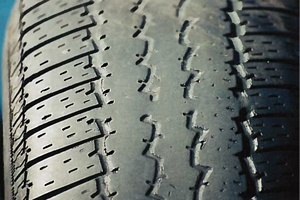
(Overinflation tire wear)
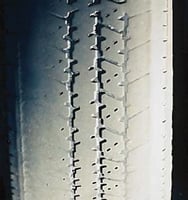
(Underinflation tire wear)
Inflate your tires to the correct levels that are consistent in each tire. Imbalance leads to shorter tire life or even a fire or blowout.
Experts base tire pressure recommendations on the worst-case load that a vehicle will endure. When inflation pressure is too high or low for your load, the tire footprint can wear down, leading to:
2. “Your alignment is off.”
Maintaining proper alignment helps keep tires running smoothly, maximizing their useful lives.
"Toe" is the most common steer axle alignment troubleshooters address. This simple measure ensures you won't face outer shoulder wear on both steer tires ("toe in"), or inner shoulder wear ("toe out").
Don't stop there. All axles of the truck (and trailer, if you’re using one) need to work as a system. The only proper alignment is a full vehicle alignment. “Thrust” and “scrub” are rear axle alignment angles you must fix to avoid premature wear on both steer and drive tires. Misaligned axles fight each other, and the effects will show in the diminished life of your tires.
3. “Your driver is crazy.”
Now matter how much you prepare and maintain your tires, a reckless driver can unravel your hard work. Tires show proof of bad driving habits and the driver’s lack of tire care. Tires can clearly indicate:
- High-power or jackrabbit starts
- Lack of regular inflation
- Brake skids: Your tire may develop flat spots if your driver is slamming on the brakes.
Another thing to drill in your drivers: If they run over debris on the road, they shouldn’t keep driving. They must pull over and inspect the tires for damage.
Fortunately, there are tools available to make it easier on drivers. For example, if a truck has an air pressure monitoring system, he’ll be warned of air pressure loss.
4. “Are we right for each other?”
Tires keep getting more and more specialized.
Make sure you have the correct tire design for your specific service vocation and wheel position. Some tires are best suited for handling frequent turns. Others are born to absorb constant starts and stops.
One example we’ve seen of an error in choice: A deep tread depth rib tire was placed on a slow-wearing linehaul, coast-to-coast operation, causing shoulder step wear. The right choice? A slow-wearing, shallower tread depth design.
Don’t forget to also take into account what your fleets are picking up. Overloading a vehicle can cause heat buildup and structural damage -- not good for your wheels.
5. “Your suspension stinks.”
Maybe your problem is a worn or broken suspension -- it naturally wears over time, so don’t feel bad. Steer tires develop irregular wear if there are issues with steer axle components. Look for these component issues that may lead to tire wear:
- Loose wheel bearings
- Weak or worn shock absorbers
- Weak or worn tie rods
- Worn kingpin
- Worn front suspension fasteners
- Improperly adjusted air springs
- Worn steering component connections
For drive or trailer axles, keep tabs on:
- Weak or worn shock absorbers
- Loose axle U-bolts
- Poorly functioning ride control systems
- Worn bushing
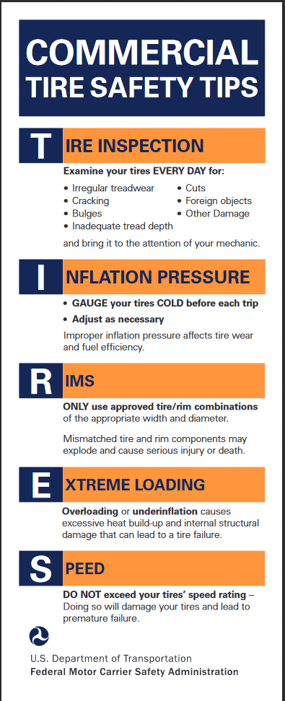
This U.S. government-produced infographic also summarizes tire safety nicely.
Stay on Top of Tire Wear
Drivers are your fleet’s first line of defense, so educate them first on how to keep your commercial tires happy. If they aren’t reporting issues back to you, they’re doing you a disservice.
Another valuable practice is to work closely with your tire professional to choose the proper design. Meanwhile, a good technician can look at a tire and quickly diagnose a wide array of problems, including:
- Bad driver behavior
- Alignment issues
- Wrong tire choice
- Worn components
Now go get the right tires! And if you need more general tips on picking the right commercial vehicle, check this out.

